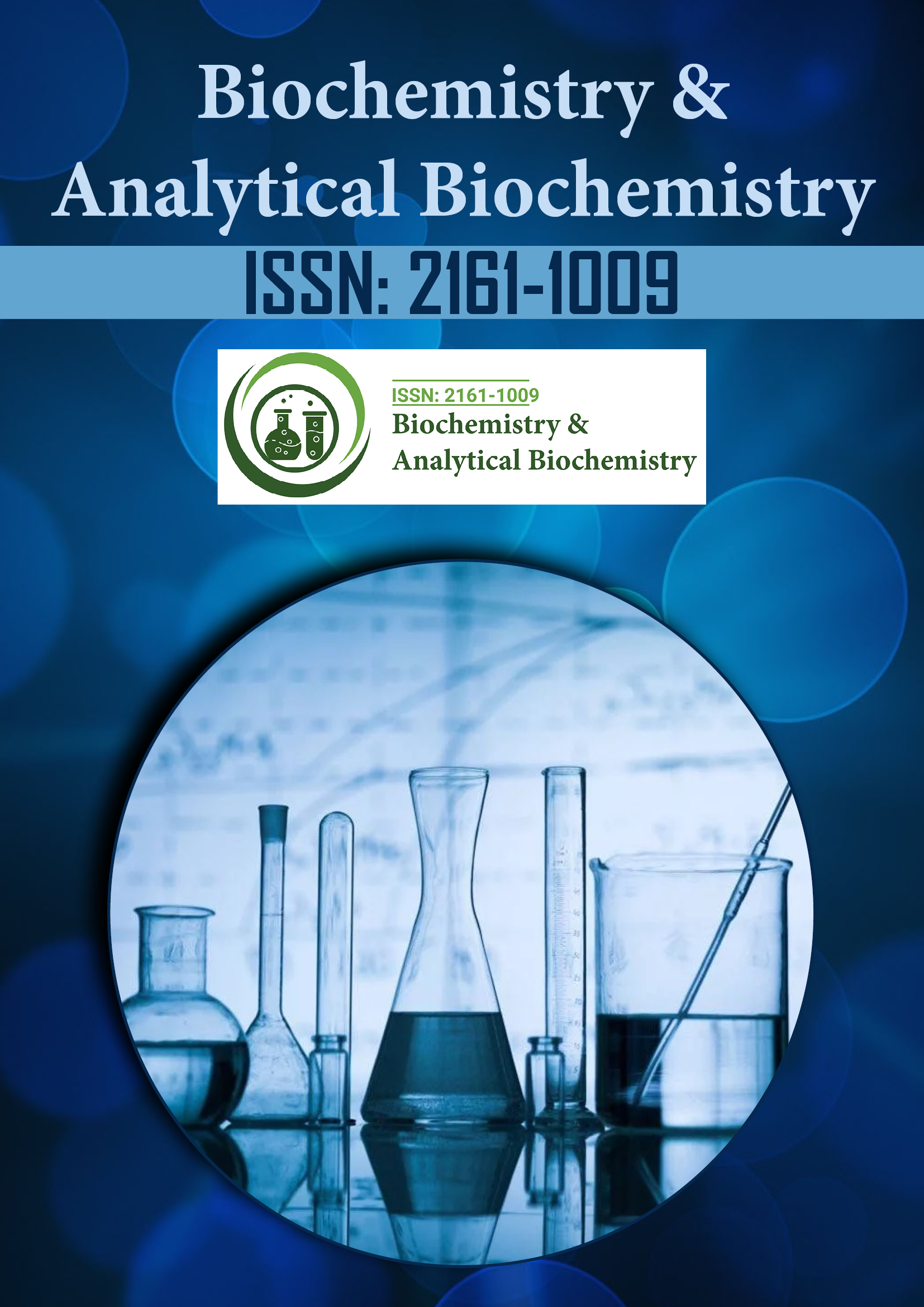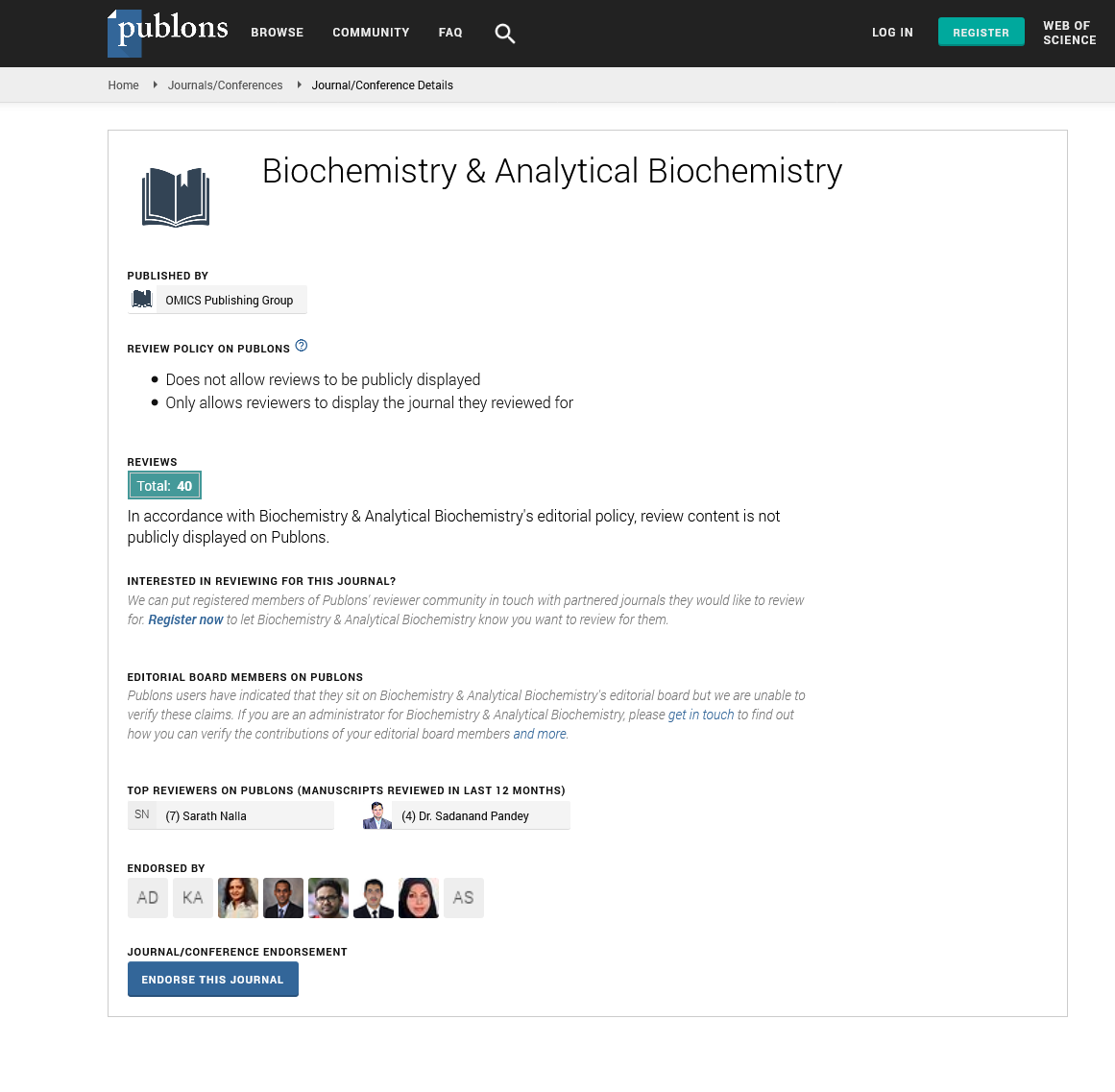Indexed In
- Open J Gate
- Genamics JournalSeek
- ResearchBible
- RefSeek
- Directory of Research Journal Indexing (DRJI)
- Hamdard University
- EBSCO A-Z
- OCLC- WorldCat
- Scholarsteer
- Publons
- MIAR
- Euro Pub
- Google Scholar
Useful Links
Share This Page
Journal Flyer

Open Access Journals
- Agri and Aquaculture
- Biochemistry
- Bioinformatics & Systems Biology
- Business & Management
- Chemistry
- Clinical Sciences
- Engineering
- Food & Nutrition
- General Science
- Genetics & Molecular Biology
- Immunology & Microbiology
- Medical Sciences
- Neuroscience & Psychology
- Nursing & Health Care
- Pharmaceutical Sciences
Short Communication - (2025) Volume 14, Issue 2
The Expanding Role of Metabolomics in Modern Biochemical Research
Elena Marquez*Received: 30-May-2025, Manuscript No. BABCR-25-29502; Editor assigned: 02-Jun-2025, Pre QC No. BABCR-25-29502 (PQ); Reviewed: 16-Jun-2025, QC No. BABCR-25-29502; Revised: 23-Jun-2025, Manuscript No. BABCR-25-29502 (R); Published: 30-Jun-2025, DOI: 10.35248/2161-1009.25.14.586
Description
Metabolomics has gradually evolved into a vital field of study that bridges the gap between genetic potential and phenotypic expression in living organisms. It is defined as the large-scale study of small molecules known as metabolites, which are the end products of cellular processes. Unlike genomics, which describes possible functions encoded in DNA, or proteomics, which maps proteins involved in biological pathways, metabolomics provides a real-time snapshot of the physiological state of cells, tissues, and organisms. This unique ability to reflect ongoing biochemical activity has made metabolomics one of the most powerful tools in modern biochemistry and analytical biology [1-3].
The emergence of advanced analytical tools such as Nuclear Magnetic Resonance (NMR) spectroscopy and Mass Spectrometry (MS) has greatly accelerated progress in metabolomics. These technologies allow researchers to detect, identify, and quantify hundreds to thousands of metabolites simultaneously, giving unprecedented insight into the biochemical networks that maintain life. For example, Ultra- Performance Liquid Chromatography Coupled with tandem Mass Spectrometry (UPLC-MS/MS) is now a standard platform for metabolomic studies, enabling precise separation and quantification of metabolite species with high sensitivity and reproducibility [4,5].
One of the most exciting applications of metabolomics lies in disease research, particularly cancer. The Warburg effect, first described nearly a century ago, highlighted that cancer cells preferentially metabolize glucose through glycolysis even in the presence of oxygen. Metabolomic profiling has not only confirmed this altered pathway but also revealed additional metabolic signatures that distinguish different cancer types. Such signatures have the potential to become diagnostic biomarkers, allowing for earlier detection and more effective monitoring of treatment response. Furthermore, cancer metabolomics provides insight into potential therapeutic targets, as interfering with specific metabolic pathways can starve cancer cells of the resources they require for uncontrolled growth [6-8].
Beyond oncology, metabolomics is also being applied in neuroscience, cardiovascular disease, diabetes, and infectious disease research. In Alzheimer’s disease, for example, metabolic disturbances in lipid and amino acid pathways have been detected in patient samples, offering clues to disease mechanisms and possible therapeutic strategies. In cardiovascular diseases, altered metabolite levels linked to energy metabolism and oxidative stress serve as indicators of disease progression and risk stratification. Infectious diseases such as tuberculosis and malaria have also been studied using metabolomics, revealing unique pathogen-related metabolic signatures that can aid in diagnosis and treatment optimization.
The field of personalized medicine has been greatly enriched by metabolomics. Each individual has a unique metabolic profile influenced by genetics, diet, lifestyle, and environment. By analyzing these profiles, physicians can tailor treatments to maximize efficacy and minimize adverse effects. For instance, pharmacometabolomics seeks to understand how differences in metabolism affect drug responses, providing a foundation for personalized drug dosing and selection. This approach has already been applied in antidepressant therapy and oncology, demonstrating the practical utility of metabolomics in clinical decision-making.
Agricultural science is another field where metabolomics has found significant application. Plants produce an extraordinary diversity of secondary metabolites that influence growth, stress resistance, and nutritional value. By profiling these metabolites, researchers can identify molecular markers for crop improvement, enabling the development of varieties that are more resilient to drought, pests, and soil limitations. Moreover, metabolomics can improve food quality and safety by detecting contaminants or verifying authenticity [9,10].
Despite its promise, metabolomics faces several challenges. Data interpretation remains a complex task due to the sheer number and diversity of metabolites. Unlike genomes or proteomes, metabolomes lack standardized databases, and many metabolites remain unidentified. Furthermore, metabolite concentrations can vary significantly depending on diet, circadian rhythms, or environmental exposures, complicating reproducibility and interpretation. Advances in bioinformatics and machine learning are now being employed to handle this complexity, offering tools for integrating metabolomic data with other “omics” layers such as genomics, transcriptomics, and proteomics. This systems biology approach provides a holistic view of biological function, which is essential for understanding complex diseases and physiological processes.
References
- Saha MS, Carline KB, Eibner-Gebhardt MW, Hussey GE, Royster MO. Engineering development: From the Repressilator and toggle switch to synthetic developmental biology. Dev Biol. 2025.
- Kakebeen AD, Fandel JY, Niswander LA. The neural tube CURE: Engaging undergraduate students in a relevant developmental biology research course. Dev Biol. 2025.
- Paredes O, Prinz R. The scientometric approach to code biology: What the title tells about the field. BioSystems. 2025;7:105552.
- Pashay Ahi E, Khorshid M. Potentials of RNA biosensors in developmental biology.2012.
- Didier J, Croce S, Bayoumi S, Valceschini E, Escoffier H, Gonzalez E, et al. Challenges and opportunities in systems biology education. Endocr Relat Cancer. 2025;32(6). [Google Scholar]
- Concha ML, Gaete M, Marcellini S. Developmental biology in Chile: An open window to Latin America and the world. Differentiation. 2025.
- Ramirez JA, Smith MR, Speight RE, O’Hara I. Framing synthetic biology as an innovation-driven market. Trends Biotechnol. 2025; 43(8):1817-1820.
- Yin Y, French CE, Lu Z. Pollutant degradation in saline wastewater using synthetic biology. Trends Biotechnol. 2025.
- Ma R, Zhao S, Jin Y, Li Y, Tang H, Hu M, et al. Advancing biomaterial innovation for tissue engineering through microbial synthetic biology: A review. Int J Biol Macromol. 2025;11:146771.
- Elbatarny M, Lu YT, Hu M, Coles J, Mital S, Ross-White A, et al. Systems biology approaches investigating mitochondrial dysfunction in cyanotic heart disease: A systematic review. EBioMedicine. 2025;118.
Citation: Marquez E (2025). The Expanding Role of Metabolomics in Modern Biochemical Research. Biochem Anal Biochem. 14:586.
Copyright: © 2025 Marquez E. This is an open access article distributed under the terms of the Creative Commons Attribution License, which permits unrestricted use, distribution, and reproduction in any medium, provided the original author and source are credited.

